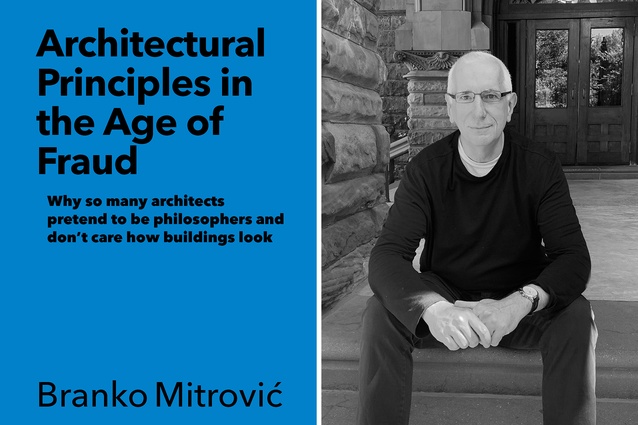In defence of modernism
Architect Peter Parkes gives a different reading of Branko Mitrovic’s Architectural Principles in the Age of Fraud.
Following Mike Austin’s review (28 June 2022) of Architectural Principles in the Age of Fraud: Why so many architects pretend to be philosophers and don’t care how buildings look, my curiosity was piqued enough to read it.
Austin gives a comprehensive description of the book, by his former teaching colleague and self-proclaimed authority on classicism,1 outlining Mitrovic’s expose of strands of architectural theory, from modernism through to deconstructionism. My reading soon became challenging. Some of his contentions clashed with valued design views.
A central contention of the book is that many of the leading proponents of these movements have exhibited an obfuscation in their writing, what Mitrovic calls the “Obfuscatory Turn”.2 I agree with him here. For me, much architectural writing from leading proponents of these movements from the late ’80s onwards, is often impenetrable, so obscure that you wonder if proofreading has become obsolete. Dense, incomprehensible text is nigh impossible to understand or to critically engage with. Sadly, through such, the status of this architecture literati gains currency. What’s more, their authority is contrived and seldom left unchallenged. Mitrovic ought to be applauded for speaking out. I take it that he views this pretentious treatment of meaning as intentional deception, thereby constituting towards his thesis of fraud, the ‘obfuscatory turn’. Fair criticism I say.
However, the scope of his analysis of the obfuscation practice is for me somewhat limited. It lacks a developed cultural explanation of why obfuscators carry on this way. Strangely, Mitrovic doesn’t seem wedded to the understanding of such phenomena by analysing its relation to broader society, including education institutions and design careers. For instance, how does such writing produce and reproduce wider social conditions? He seems to shun sociological or cultural analysis as a fruitless pursuit. Here I must disagree with him. As human activity is carried out in social contexts, one very useful research approach is to investigate how and why such behaviour produces and reproduces broad social conditions.
Mitrovic also has a gripe with these leading writer/architects grandstanding as philosophers. He treats such borrowing from philosophy, as if it were a crime, a fraud. To the contrary, I have no umbrage with architects borrowing thought, as thinking is fundamentally a social product in the first place and everyone is a borrower of ideas if it comes to that. Everyone who thinks (the vast population of humankind!) and reflects on thought is by such terms, a ‘philosopher’. Seemingly, as he has a degree in philosophy as well as architecture, he is better qualified and other architects less so! This could be seen as a stance of superiority, elitist positioning, defending a supposed expertise in a patch of contestable knowledge.

As well as being protective of his views on ‘real philosophers’, in his next major contention in the book, he argues for classicism over modernism – a strange accompanying argument. Apparently, modernist pioneers and its later proponents have committed a ‘fraud’ as their education credentials and writings lack credibility as they pretend to be philosophers. And another bewildering contention is that modernist buildings are ugly and classical not so! For a self-professed educated philosopher, the logic and its inconsistency flaw me.
He shuns much of modernism and its later manifestations in favour of a return to ‘traditional classicism’ particularly works of the Italian Renaissance architect Palladio from the 16 century. For me, this is an unconvincing, contentious stance. Whilst modernism in its many nuances, can be viewed as having residual aspects of classicism,3 it was an enormously bold, radical new departure in design practice. Perhaps, it could be considered as one of the most far-reaching movements in aesthetic development and dissent in human history.
As it’s likely that many readers of this journal will appreciate, Modernist protagonists were fuelled by radical desire to oppose the dominant European culture which gave rise to the two world wars. Modernists dissented from the then mainstream designers that used residual classical forms of ancient Greek and Roman for symbolism. Modernists viewed classicism as the style of conservatism, the symbolic preference of many those institutions in power: conservative and imperialist governments, royalty and other undemocratic entities, authoritarian and fascist regimes. Classicism represented the power of Roman imperialism, through its formal hierarchical based compositional orders, symmetrical and axial planning, monumentalism, permanence and supposed timelessness.
Modernists resisted classical, formally based compositional arrangements of proportion, scale, balance and use of ornament. They, in stark opposition, embraced new aesthetic sources to symbolise a hopefully more democratic social order. The war-torn world needed a new aesthetic to symbolise a new and optimistically different world. The modernist aesthetic came from a pragmatic need to design a new world, a fresh new aesthetic for a world liberated from war. The new aesthetic composition had to symbolize emancipation, freedom, hope, release, austerity, equality and fairness. This it did, in the main, through experimentation with new building materials and construction types, new attitudes to space, light, colour and abstract geometrical composition and minimal ornamentation. Modernists pressed for new forms of living and work that reinvigorated hope for future humanity. The new creativity spanned across all human produced objects for living. In short, modernism sprang as a critical reaction to widespread global destruction. Importantly, for my argument here, modernism despite all its many shortfalls, had a socially responsible political purpose. It was socially relevant to its times, a means to heal the world.
Given such a view of modernism, for Mitrovic to suggest that re-invoking classicism is appropriate for today as it supposedly, ’looks less ugly than late modernist architecture and its variants’, is almost beyond belief. For a start, it trivialises the complex array of historical issues in symbolism, building design and construction. Surely, architecture is much more than mere issues of visual appearance. Social legitimation of design is more complicated than confined to matters of visual appeal. Afterall, post-modernism, the pinnacle of recent superficiality, didn’t help in its goal of fixing legitimation issues in architecture. Embracing supposed popular imagery from commercialism and bygone historic periods didn’t work. Simply put, attending to just appearances of buildings doesn’t address the broad societal conditions of building production. It doesn’t grapple with existing conditions and the vagaries of construction markets. The professional ideology, social roles, attitudes, and beliefs that prevail in mainstream architecture, are largely left unchallenged, uncontested. Focusing principally on matters of appearance can be viewed as maintaining prevailing social order. Ordinary professionalism with its arguable flagging social power, is upheld. This means of occupational control over specialist building design is given further currency.4
Further, and perhaps of greater importance and indeed urgency; how could classical principles of building and appearance help in wrestling with the many pressing issues confronting the world today? I cannot conceive of any historic residual value derived from classical building, apart from stone as thermal mass, that would help to confront the prescient issues of current times: climate change, environmental destruction, nuclear catastrophe, homelessness and expanding poverty under neoliberalist market economies.
It’s hard to conceive of built form as anything other than being a product of its historic era. Buildings as cultural products manifestly represent and reproduce the circumstances of their era. Their reason for being stems from the conditions of their times. They come to be symbolic of social circumstances. Building users attribute meaning to them in a variety of ways relevant to their lives. Accordingly, building form can be analysed according to its relation to variable cultural situations. It can be considered as a vehicle for reproducing cultural dominance (eg. as investments to make profit). On the other hand, it can be viewed as symbolic of struggles against dominance where radically new forms emerge (early modernist aesthetic). Also, they can be viewed as continuance to some degree of past relevant conditions and deemed to reproduce, what I take as residual form.5
Modernism, again, despite its many inconsistencies, variances, appropriation by building developers and speculators, flaws, including obfuscation by its latter advocates; had a hopeful future looking focus with social relevancy and democratic intent. Protagonists believed fundamentally in human progress, that people’s lives can be enhanced by socially responsible design, that impoverished social conditions can be changed or at least improved by design. Modernism was and still remains, in part, a means to grapple with social emancipation. In today’s world, residual modern design practice is still, seemingly at work with a refocused goal of providing relief within neoliberal economies, addressing not least, the threat of global extinction through human fuelled climate change.
This modernist legacy is most notably demonstrated by architects, many of the non-award driven kind, that are hugely politically committed to the survival of humanity. Modernity, grown from the enlightenment, anchored in reason and democracy, intent on social emancipation and a catalyst for social change, has much remaining validity in our times.6 It’s extremely difficult to envisage how a return or embrace of key principles of classicism will help to save the planet and humankind from itself. On this note, to be unapologetically blunt, Mitrovic’s fanciful embrace of classism borders on farce.
Mike Austin’s review from Architecture NZ May/June 2022 can be read here.
1 It is suggested to read Mike’s review first.
2 Since writing this book, Mitrovic presented a paper in Madrid, 15 June 2022 titled ‘How to Study the Obfuscatory Turn in Postmodernist Architectural Theory’.
3 For example geometrical harmony and utility of built objects.
4 My PhD thesis examines this issue, ‘Post-Modern Architecture Theory: A Critique’, Welsh School of Architecture, UWIST Feb 1986.
5 Indebted here to the Welsh Professor of literature and dissent, Raymond Williams, ‘Culture’, Fontana Paperbacks 1981.
6 Readers may like to refer to an essay by the German philosopher ‘Modernity – And incomplete project’, first published as ‘Modernity versus Postmodernity’ in New German Critique 22, 1981.










